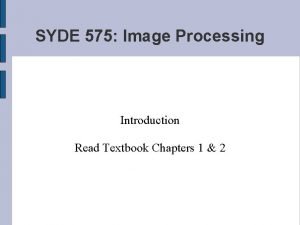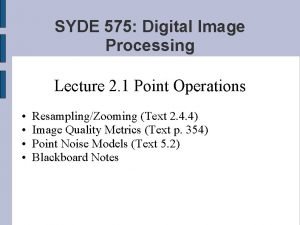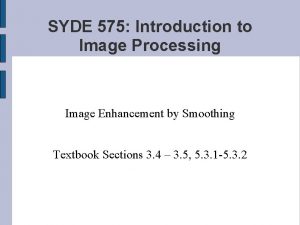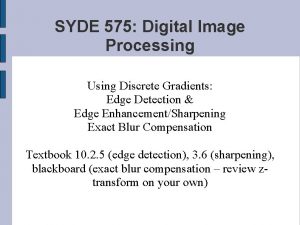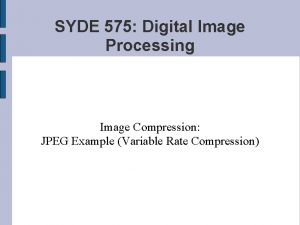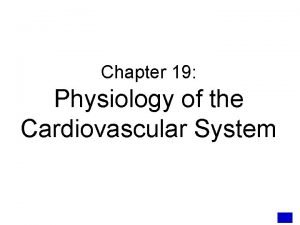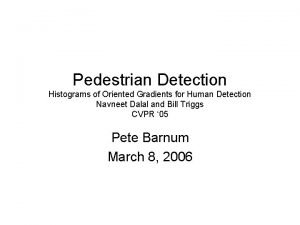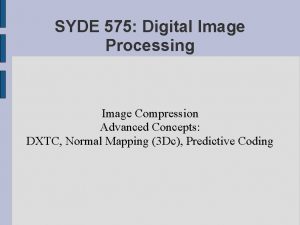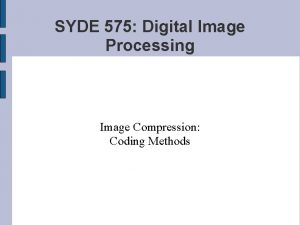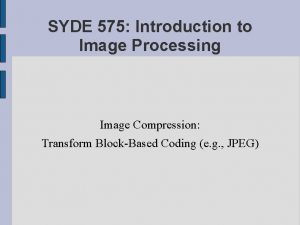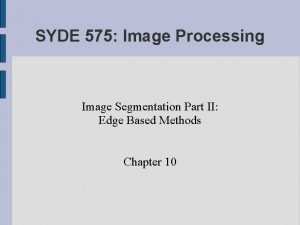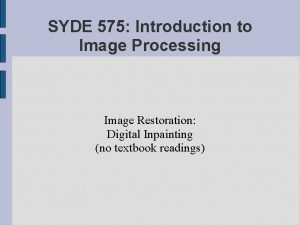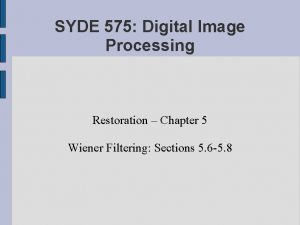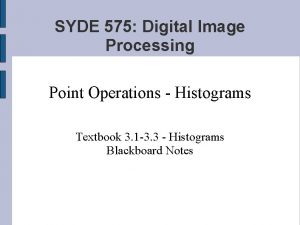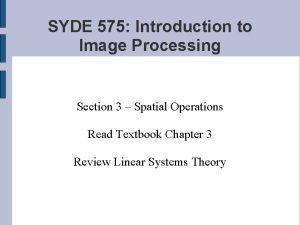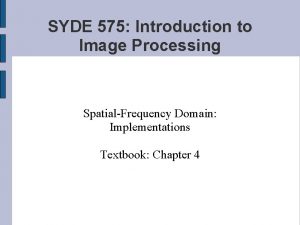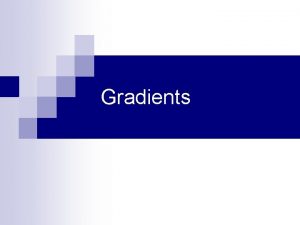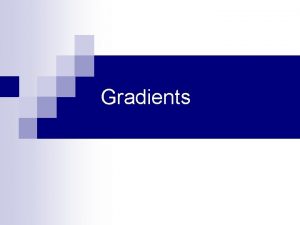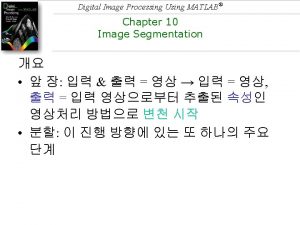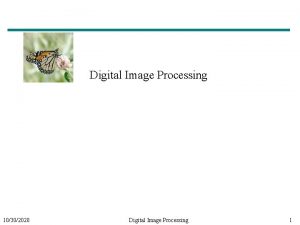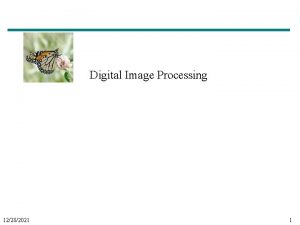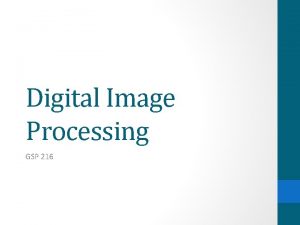SYDE 575 Digital Image Processing Using Discrete Gradients



























- Slides: 27

SYDE 575: Digital Image Processing Using Discrete Gradients: Edge Detection & Edge Enhancement/Sharpening Exact Blur Compensation Textbook 10. 2. 5 (edge detection), 3. 6 (sharpening), blackboard (exact blur compensation – review ztransform on your own)

Edge or Gradient Detection Why are edges important? Psychovisually, most important characteristic that HVS identifies. 1) Difficult to distinguish two similar grey levels unless side-by-side with a boundary separating 2) Phase vs. magnitude: reconstruct an image with only phase and structure is retained; reconstruct using only magnitude and an unintelligible image is produced (Lab #3)

First Derivatives Implemented as magnitude of gradient in image processing These are continuous – implement in discrete fashion (Dx, Dy) for digital image processing

First Difference • Implement discrete derivative using first difference e. g. , Dx = f(m + 1, n) – f(m, n) = [ -1 1 ] (as a mask) Dy = f(m, n + 1) – f(m, n) = [ -1 1 ]’ = Dx’ (as a mask) • Another method: Roberts Cross Operator | Df(m, n) | = | f(m, n) – f(m+1, n-1) | + | f(m, n-1) – f(m+1, n) |

First Difference • First difference operators are not effective • Very sensitive to noise because of small spatial extent • Solution: use a larger mask

Gradient Masks Source: Gonzalez and Woods

Example: Defect Detection Source: Gonzalez and Woods

1 -D Example

Edge Detector Characteristics a) Negative weights required b) Zero DC gain c) Non-causal d) Typically odd dimension e) Odd symmetry

Canny Edge Detector (1986) • Advanced method for edge detection • Canny specified 3 issues an edge detector must address: 1) Error rate: edge detector must respond only to edges and detect them all 2) Localization: distance between detected edges and true edges must be minimized 3) Response: do not identify multiple edge pixels where only a single edge exists

Canny (cont. ) • Canny assumed step edge w/ point Gaussian noise • Tried to derive single filter to optimize edge detection based on these 3 criteria for given edge model • Outcome too complex to be solved analytically! But a reasonable solution is a derivative of a Gaussian • So, step * Gaussian * edge detector = ? ?

Canny (cont. ) • Step 1: convolve image with derivative of a Gaussian • Step 2: non-maximum suppression – Thins edge boundary to 1 -pixel thick – Threshold based on direction of gradient – Magnitude of gradient at edge pixel should be greater than magnitude of gradients on each side of edge • Step 3: hysteresis – Two thresholds, Th and Tl – Any gradient bigger than Th, automatically an edge – Iteratively, any pixel connect to Th with gradient > Tl automatically an edge as well

Spatial Filtering: Sharpening Goal: highlight or enhance details in images Some applications: Photo enhancement Medical image visualization Industrial defect detection Basic principle: Averaging (blurring) is analogous to integration Therefore, logically, sharpening accomplished by differentiation

Comparing First and Second Derivatives First derivative Second derivative

Derivatives of Digital Function Second-order derivatives have stronger response to fine detail (e. g. , thin lines and points) Second-order derivatives have a non-zero response to ramps First-order derivatives have stronger response to step changes Second-order derivatives produce double response at step changes

Example Source: Gonzalez and Woods

Laplacian Second-order derivatives in 2 D described by the Laplacian

Discrete Laplacian Filter

Laplacian Filter Source: Gonzalez and Woods

1 – Laplacian in Practice • How can the second derivative (Laplacian) be used?

Example Source: Gonzalez and Woods

Sharpening using Unsharp Masking Process used for many years in publishing Subtract blurred version of image from the image itself to produce sharp image gmask(x, y) = f(x, y) – m(x, y) g(x, y) = f(x, y) + k gmask(x, y) output input edge map k=1 -> unsharp masking k>1 -> high boost filtering

Example Source: Gonzalez and Woods

Impulse Response for Unsharp Masking

Example Source: Gonzalez and Woods

Edge Enhancement Filter Characteristics a) Even symmetry b) Negative weights (surrounding) c) DC gain of 1 These aspects characterize ‘lateral inhibition’ (see earlier in the course) • Neighbouring inputs inhibit response of a pixel • Well-known as a model of neural interaction in the HVS

Exact Blur Compensation • Use of complex number to solve difference equation representing inverse system • Use of z-transform for solving inverse system for general blur model • Blackboard notes
 Syde 575
Syde 575 Syde 575
Syde 575 Syde 575
Syde 575 Syde 575
Syde 575 Syde 575
Syde 575 Histogram processing in digital image processing
Histogram processing in digital image processing Neighborhood processing in digital image processing
Neighborhood processing in digital image processing Nonlinear image processing
Nonlinear image processing Image processing
Image processing Define point processing
Define point processing Thinning and thickening in image processing example
Thinning and thickening in image processing example Image transform in digital image processing
Image transform in digital image processing Optimum notch filter in image processing
Optimum notch filter in image processing Image compression model in digital image processing
Image compression model in digital image processing Image segmentation in digital image processing
Image segmentation in digital image processing Image compression model in digital image processing
Image compression model in digital image processing Image sharpening in digital image processing
Image sharpening in digital image processing Geometric transformation in digital image processing
Geometric transformation in digital image processing Digital image processing diagram
Digital image processing diagram Image transforms in digital image processing
Image transforms in digital image processing Image geometry in digital image processing
Image geometry in digital image processing Noise
Noise Histogram of oriented gradients for human detection
Histogram of oriented gradients for human detection Pressure gradients in the heart
Pressure gradients in the heart Histograms of oriented gradients for human detection
Histograms of oriented gradients for human detection Authority gradients
Authority gradients Mpp algorithm in image processing
Mpp algorithm in image processing Representation and description in digital image processing
Representation and description in digital image processing
